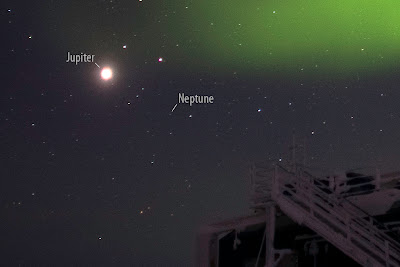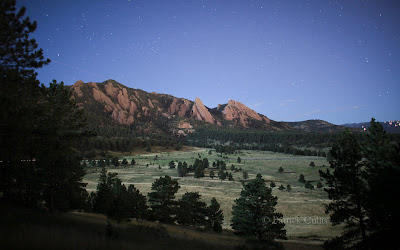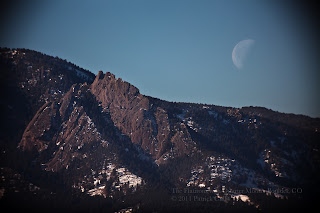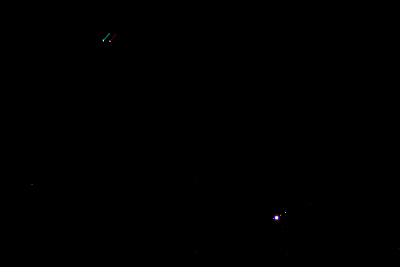I've been working a lot with the images that have quickly been piling up on my hard drive since I first bought my telescope. Astrophotography is a strange form of photography for me. I've always kind of hated Photoshop and software gimmicks because it feels like cheating to me. I've always tried to keep my editing changes to the whole image. Now with astrophotography I'm forced to combine tens or even hundreds of images down to a single picture and really stretch the color and exposure to bring out the detail. I think I might be alright with that. I really like the pictures that I'm getting and actually feel they are representative, but it still feels feels like cheating.
Friday, December 30, 2011
Little by Little...
The Universe Today Guide to the Night Sky - January
I was checking out one of my favorite websites on astronomy and they happened to post a guide to the night sky for the month of January. I was reading through it and when I came to the section on Orion I suddenly said, "Dang, that picture looks a lot like mine..."
Wednesday, December 28, 2011
Earthshine
Some of the neighbors came over to look through binoculars and my telescope setup in the back yard. It was a lot of fun and was awesome to have someone else to talk to about the sky, new targets to point the scopes at, and of course our dream telescopes.
When I first went out to put the telescope up, the small crescent moon was getting ready to set above the tree line and the neighbors house. It really is amazing how good the human eye is at some things. Looking at the crescent moon, the eye can properly expose both the light AND dark of the moon AT THE SAME TIME!!! I wish my camera could do that. Here is the moon exposed to bring out the earthshine glow of the dark section. It is illuminated solely by the double reflected light bouncing off the earth, off the moon, and then finally back down to us.
When I first went out to put the telescope up, the small crescent moon was getting ready to set above the tree line and the neighbors house. It really is amazing how good the human eye is at some things. Looking at the crescent moon, the eye can properly expose both the light AND dark of the moon AT THE SAME TIME!!! I wish my camera could do that. Here is the moon exposed to bring out the earthshine glow of the dark section. It is illuminated solely by the double reflected light bouncing off the earth, off the moon, and then finally back down to us.
Monday, December 26, 2011
The Video Advantage -
I woke at 4:30am Christmas morning because the dog kicked me in the neck. After shoving the brown bear away from my face and the prime real estate of the bed, I happened to wake enough to see what time it was and was warm enough to check what the sky looked like outside the window. It was crystal clear and I decided to throw the telescope outside and take my first real look at Saturn. Honestly the most beautiful planet in the solar system, I have only had one brief glimpse of it since being shown to the eyepiece of the telescope by my father as a small child. I'm not sure if the memory is real, or if it is just recreated in my mind, but regardless, seeing it once again is awe inspiring. Currently, my camera cannot capture just how good it looks visually in even my 4" telescope. I hope to get some better representations up on the blog before the new year.
I also took a couple of minutes of video. Using software called Registax, I was able to combine several minutes of video in to a single image. The software is able to filter out the flutter and wiggle of the atmosphere to make a much sharper image of planets. It's pretty amazing. I can't wait to get a bigger scope...
I also took a couple of minutes of video. Using software called Registax, I was able to combine several minutes of video in to a single image. The software is able to filter out the flutter and wiggle of the atmosphere to make a much sharper image of planets. It's pretty amazing. I can't wait to get a bigger scope...
Thursday, December 22, 2011
Getting Fainter
Finally did some research, and this picture comprises M42 - The Great Orion Nebula, M43 is the small but bright bit of nebulosity just to the top of the bright trapezium stars, separated by the lane of dark dust. The blue nebula to the top is called "the Running Man Nebula" or NGC 1973/1975/1977.
I promise that I'm still taking pictures of things other than stars. It's just the thing that I'm currently obsessing about during my short windows of free time to edit on the computer.
I was finally fortunate enough to get a window of semi-clear skies and got to set up my scope for a good run at Orion. I have a new sky-glow filter that lets me combat the haze from Boulder, and I wanted to see how long I could push the exposures now. I started at three minutes and worked my way up to ten minutes at ISO 1600. Ten minutes actually gave me an amazingly good looking black where the sky in fact should be black. It's hard to do test shots that last ten minutes, so I went and got a pillow and a big piece of cardboard and laid down on the concrete in my big down puffy and practiced the names of stars while I waited for the shutter. I was really happy with the faint nebulosity that showed up in these longer exposures, especially in the blue reflection nebula to the north of M42. Now I need to work on some combined exposures so that I don't lose all of the detail around the bright trapezium stars.
Sunday, December 18, 2011
A Short Night
With the forecast looking good and the early sky crystal clear, I was excited to set up my telescope over the weekend. Finally the moon was out of the way and I was planning on a good session at the scope. I was able to get a handful of pictures before some unexpected wispy clouds moved over the flatirons and spoiled the evening.
M15 is one of the most densely packed globular clusters in our galaxy and it is suspected that the central core has collapsed on itself to form a central black hole.
Once the clouds started to move in, I switched over to a regular camera lens and the ball head joint so that I could pick out spots in clear pockets. One of those spots contained the Andromeda Galaxy hanging above one of our pine trees.
The Belt and Sword of Orion. A wider view of the three belt stars and sword containing the Great Orion Nebula. Just to the side of the left belt star is the faint inkling of the flame nebula.
Saturday, December 17, 2011
Quarter Moon
On Saturday the moon took a fortunate angle while setting behind the Flatirons. I was able to get a few pictures of the quarter moon dropping down behind the iconic rock formation.
It's been unbelievably clear out, which has been absolutely terrible for my ski craving, but pretty awesome for photographing the sky. Hopefully the forecast holds up tonight and I can finally use my new filter for taking pictures of some stars and nebula. Fingers crossed!
It's been unbelievably clear out, which has been absolutely terrible for my ski craving, but pretty awesome for photographing the sky. Hopefully the forecast holds up tonight and I can finally use my new filter for taking pictures of some stars and nebula. Fingers crossed!
Wednesday, December 14, 2011
Sunrise After the Eclipse
So I finally had time to look back at the lunar eclipse pictures I took and realized that there were some pretty ridiculous ones I hadn't seen while rushing through them to put out a post. After the moon set, I had a beautiful sunrise that began to light up the mountains. With the power of my new telescope, I was able to drastically compress the distances and create an almost "tilt-shift" feeling to the scenery. I didn't actually do much editing to get these images.
The first and second flatiron above Boulder, Colorado. Behind the rocky slabs the snow covered mountains of Indian Peaks and the Great Divide stand large.
14,259 foot tall Longs Peak glows orange with the morning sun on a crisp morning in December.
The Boulder power plant and Colorado Front Range.
Houses in the foothills of Boulder hunker down on a chilly morning below the massive form of Longs Peak.
The Colorado Front Range north of Boulder, CO
The Flatirons of Boulder, CO
Saturday, December 10, 2011
Lunar Eclipse - Dec 10, 2011
The lunar eclipse above Indian Peaks. Shot from just outside Boulder, CO, the Indian Peaks run along the continental divide. The moon set just before totality on the morning of December 10, 2011. It was a very impressive sight.
The lunar eclipse setting just before reaching totality.
An earlier view of the moon right at the beginning of the eclipse.
Midway through the lunar eclipse. You can just start to see the orange glow of the moon in Earth's shadow.
There are also more pictures, and higher-res versions on MY FLICKR GALLERY
I will also be adding higher quality pictures of the eclipse over the next couple of days, but need to do some work on them.
Monday, December 5, 2011
The Moon
The sky above Boulder finally cleared and I was able to test some equipment out that I've been dying to get going. I didn't stay out long considering it was only 4 degrees outside, but I set up my new battery and inverter running the tracking mount for the first time. I pointed the scopes at the moon for the first time in a couple of months and started recording a movie. After a couple hours of compressing the video frames in to a single image, this is what popped out the other end! Still seems a tad over-sharpened, but it's amazing what kind of detail can be teased out of 2,000 images...
Saturday, December 3, 2011
The Universe Today
I made it on to one of my favorite astronomy websites called Universe Today! Fraser Cain and Dr Pamela Gay run a weekly podcast called Astronomy Cast. After starting to get in to astrophotography, I posted a handful of star photos on their Flickr page and they decided to put this one of the Scott Tent up on their website. Check them out!
Monday, November 28, 2011
The Great Orion Nebula
I finally got a clear night with the telescope and got some shots of the Orion Nebula. It was my first try at stacking photos in order to really filter out the noise inherent in long exposures. This photo was created with ten two minute exposures of the nebula. The software is amazingly confusing the first time through. A lot like your first crack at doing just about anything in Photoshop. I think I'll get better at it after a little trial, error, and googling...
Friday, November 25, 2011
Taking a Closer Look
I've been looking back through a lot of the less-amazing pictures I took while living at the South Pole. With some of the new stargazing tools I have come across since buying my telescope, I have been able to better identify many of the objects hiding in plain sight. I always knew where Jupiter was during my winter, since it was the brightest object in the sky the whole time, but I was happy and shocked to learn that Neptune was also captured in this shot not too far from Jupiter.


Tuesday, October 25, 2011
Working out the kinks
I woke up the other night before twilight and captured another, much better, version of the Orion Nebula. I've finally worked out a way to get some medium zoom on the camera with eyepiece projection. In this method I actually bury the eyepiece inside of the optical setup and the sensor catches light passing through the eyepiece as your eye would. My main problem had been that the focal plane was extremely curved. That is somewhat okay for an eyeball, but makes a camera sensor think it's getting ready to go to warp 9 on the Enterprise. Needless to say I finally found a way to somewhat correct that problem. Now I just need to keep working at getting the mount aligned properly so that I can increase the shutter beyond about 30 seconds.

The Orion Nebula
This nebula, found halfway down the "sword of Orion," is made up of dust and baby stars just coming to life. The dust billows and glows in extraordinary colors as it gets blasted away from the newborn stars.

Andromeda Galaxy 2.0
I finally tried editing a few versions of the Andromeda Galaxy and came up with this.
Saturday, October 15, 2011
The New Tripod
I finally got my equatorial mount and am dipping my toes in to the possibilities it presents. Even though I can't align with Polaris from the back yard, there was a nearly full moon and I'm only using a 3" telescope, I was extremely happy with what I was able to capture.

The Andromeda Galaxy - M31, plus M32 and M110
Updated photo to a visual sky orientation from an earlier version:
I was finally able to get this shot late at night after Cassiopeia and Andromeda made their way clear from my rooftop. There was some serious haze from the moon washing out this shot. I can't wait for a clear night in a week or two when the moon is down and I should be able to get a much better exposure. The smaller galaxies M32 and M110, which actually orbit the larger galaxy, can be seen as well. M32 is up and to the left of Andromeda and looks like a large hazy star, while M110 is down and to the right and looks like a small, faint version of Andromeda.
 The tripod doesn't directly help me get a better looking picture of Jupiter, but it does make it a whole lot easier that I no longer have to manually chase the big guy as he zooms across the eyepiece.
The tripod doesn't directly help me get a better looking picture of Jupiter, but it does make it a whole lot easier that I no longer have to manually chase the big guy as he zooms across the eyepiece. Check out how Jupiter looks through the viewfinder as I'm waiting for the ripples in the atmosphere to smooth out and give me a crisp, defined shot.
Wednesday, October 5, 2011
Craters
 The moon snuck in to a small clearing of clouds last night and I finally got my first zoomed picture of the cratered surface. During my winter at the South Pole, I took hundreds of pictures of the moon while passing the time until the next aurora display. I've been waiting a long time to see detail like this on the back of my camera. There was still a thin veil of clouds moving across the disk, and it was quite amazing to see the surface literally "boil" as our atmosphere flowed above me. I had to take a dozen pictures until I got a lucky clear spot in both the clouds and the turbulence.
The moon snuck in to a small clearing of clouds last night and I finally got my first zoomed picture of the cratered surface. During my winter at the South Pole, I took hundreds of pictures of the moon while passing the time until the next aurora display. I've been waiting a long time to see detail like this on the back of my camera. There was still a thin veil of clouds moving across the disk, and it was quite amazing to see the surface literally "boil" as our atmosphere flowed above me. I had to take a dozen pictures until I got a lucky clear spot in both the clouds and the turbulence.
Wednesday, September 28, 2011
Couple More Tidbits
The stuff Messier actually WAS looking for...
 It may not look like much, but the fuzzy little star in the center of the picture is actually a comet. Comet Garradd is making it's way towards the constellation Hercules, where it will then start its swing around the Sun and back in to the cosmos come February. Hopefully it will brighten a magnitude or two as it approaches the Sun, but it certainly won't be the same sight as a Halley's or Hale-Bopp.
It may not look like much, but the fuzzy little star in the center of the picture is actually a comet. Comet Garradd is making it's way towards the constellation Hercules, where it will then start its swing around the Sun and back in to the cosmos come February. Hopefully it will brighten a magnitude or two as it approaches the Sun, but it certainly won't be the same sight as a Halley's or Hale-Bopp.Monday, September 26, 2011
Orion
I've been ridiculously spoiled the last four days with crystal clear night skies. I woke up to make coffee and realized it was both clear out, and that Orion was fully up in the pre-dawn morning. Orion is hands down my favorite constellation and the first I can remember my Dad pointing out to me as a young child. It always reminds me of winter.
 I took a couple pictures with my wide angle and then zoomed in for the first time on the sword of Orion and snapped my first clear picture of the Great Orion Nebula. Amazing...
I took a couple pictures with my wide angle and then zoomed in for the first time on the sword of Orion and snapped my first clear picture of the Great Orion Nebula. Amazing...
Saturday, September 24, 2011
Jupiter Part 2
Thursday, September 22, 2011
Astro-Boy
Update: I have corrected the links to the larger format images.
Thursday night it was really clear out and I had been wanting to see how far I can push my night/astro- photography. I have to say I'm pretty impressed with what it can do with just a 300mm lens and short exposures. Being zoomed in, I was only able to stretch the exposure to about a second and a half before the stars would streak too much. That meant a high, high ISO
First up, the Andromeda Galaxy. It's the closest spiral galaxy to our own Milky Way, and I was blown away with it when I first managed to point my binoculars in the right direction. This one I can't wait to see once I'm able to really stretch out the exposures instead of brute forcing it with ISO 25600...

M31 - The Andromeda Galaxy
I was also able to capture a planetary nebula in the constellation Lyra. This constellation has been stuck in my head ever since I first spotted it soon after my brother got his cat of the same name. The nebula is a small green disk in the center of the photo.

M57 - The Ring Nebula in the constellation Lyra.
Near 10pm Jupiter made it's way above the trees and I was able to train my sights on our solar system's largest planet and four of its moons: Io, Europa, Ganymede, and Callisto. I was amazed that I was able to actually see each moon showing up as a different color. This is another one that I can't wait to get closer on. With my current setup, Jupiter only consists of about 100 pixels on camera sensor.
Sunday, August 7, 2011
Kind of Obsessed
A few more shots of the Flatirons. I suppose (for the time being,) that I am going to fully dedicate myself to obsessing about photographing the already obsessively photographed Flatirons in Boulder. Should be fun to see if I can top what is already available out there. On more than one occasion I have been called a one-upper, so maybe it's time to embrace that and take advantage of it. Maybe I can make a calendar or something else with the Flatirons to sell to all the tourists that come through this town.
Also, I keep adding to the website. Maybe I'll get the shopping cart up soon, but hey, at least I'm working on it for once.



Thursday, August 4, 2011
Woofer Duty

I'm watching a tiny two month old pup for the week. She is adorable. She is hilarious. She chews everything in sight. The cat is in hiding. And she is pretty much the greatest thing ever...
Subscribe to:
Posts (Atom)

































 "What was that?!?!"
"What was that?!?!"
